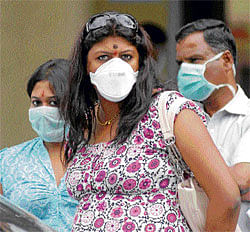
Deaths reported in the State due to H1N1 have declined steadily over the last three years.
From registering 94 deaths in 2009 and 42 in 2010 in Bangalore urban district (including BBMP area) alone, the numbers have drastically come down to one death till May this year. Bangalore urban witnessed the highest number of deaths. Districts like Belgaum, Mysore and Udupi also saw many cases in the last two years.
Noting that it was a particularly trying time for the health department, besides the common man, officials say the reason for low death rate could be possible immunity gained by the community towards the H1N1 virus. The four deaths, which occurred this year were one each in Bangalore, Davangere, Shimoga and Tumkur.
Possible rise
“There may be a rise in H1N1 cases after August,” said Dr V Ravi, head of department of neuro-virology and in-charge of the NIMHANS lab that has been testing the H1N1 samples. The reason for this is the conducive environment for the virus to spread due to rains.
Similar numbers
He added that while 30 per cent of the population was attacked in the first year, the figure was the same in the second year. Similar numbers are expected this year.
“After that, it will become like any other seasonal flu,” he said. The labs still received samples and updated the department every day.
The health officials are still vigilant and a bit wary too. “The trend is continuing but not the magnitude of infection. However, we are not neglecting the disease. Samples are being taken and suspicious cases are still there. But the intensity of the disease has lowered,” said Dr T S Cheluvaraj, joint director, communicable diseases.
The department is still receiving H1N1 cases - 846 samples were tested till May this year, of which 29 tested positive.
“The sub clinical cases will be much more,” Cheluvaraj felt.
Surveillance is still on even though the H1N1 Influenza positive cases have been in single digits since December last year.
Dr Ravi said that although there is speculation that the pandemic may have been engineered, there is no scientific evidence to prove it.
On the contrary, there is solid scientific evidence which states that a novel virus spread from US.
Excess drugs
Nearly 2,800 bottles of oseltamevir syrup (which was given to children testing positive for the virus) have their expirydate in July. Not knowing what to do with them, the department consulted the Union Health Ministry which suggested that they be given to adults too.
The syrup bottles have been dispatched to all the districts.
As for Tamiflu tablets, the department has around two lakh tablets of 75 mg dosage, 21,000 of 45 mg and 21,000 of 30 mg.
“Since the pandemic was unpredictable, a large quantity of drugs was dispatched. Now, we have asked the ministry to decide what to do with them,” said Dr Cheluvaraj.
The tablets, unlike the syrup, have a longer shelf life and have their expiry date after three years.
The State has utilised 1.1 lakh vaccines by immunising all its doctors, paramedical staff and ASHA workers.